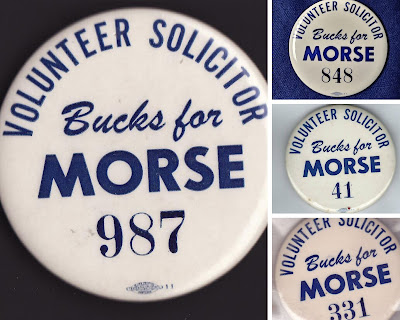I started trying to find out more about the button from the archives of the Oregonian and other Oregon newspapers. There is not much out there. The phrase 'Bucks for Morse' did show up in several articles about the 1956 campaign. This was the campaign right after Wayne Morse switched from Republican to Independent and finally became a Democrat. The Republican Party of Oregon nominated former Governor Douglas McKay, at the time he was serving in Washington D.C. as President Dwight Eisenhower's Secretary of the Interior. One instance of the phrase Bucks for Morse was found in the August 31, 1956 edition of the Salem Statesman Journal. The news clips section reads:
Anthony Vavorus, Legislative representative for the Oregon Joint Council of Teamsters, reported this week that the Teamsters' Bucks-for-Morse program was progressing satisfactory.The Teamsters' it seems created the 'Bucks for Morse' program. Other articles from the Oregonian detail that the Teamsters' union made donations totaling $17,000 to the Democratic Party of Oregon. It is unknown if this money was raised solely via the Bucks for Morse initiative.
In the mid-fifties, the union was one of the most powerful in the country and was starting to come under intense scrutiny both locally and nationally. By December of 1956, it was clear that investigations and hearings would begin in the new year by the McClellan Committee. Oregonian investigative reporters Wallace Turner and William Lambert had just spent the last year diving deep into investigations to expose organized crime connections to local government. This led the committee and it's Chief Counsel Robert Kennedy, to investigate racketeering by union officials in multiple cities across the United States.
Morse and his allies like the Teamsters' were outspent according to what few reports exist in the newspaper archives. McKay spent an estimated $188,000 while the Re-elect Morse Committee spent $89,000, and a PAC supporting Morse spent $87,000, bringing a total near $176,000 between pro-Morse forces. In the same election that President Eisenhower won Oregon with 55% of the vote, Morse only underperformed Eisenhower by 1%, earning 54% of the vote against the Douglas McKay who earned only 46% of the vote
The button stands out as the largest known Morse pin from 1956. Nearly all the other Morse pins identified from that year are 1" inch sized pins. Rumors also speak of a Stevenson-Morse coattail pin, but it has never been proven to exist. Until someone shows us one, the best Morse pin of 1956 will remain the Bucks for Morse pin.


No comments:
Post a Comment